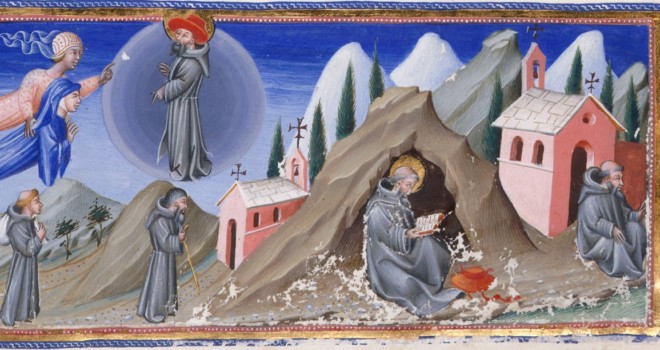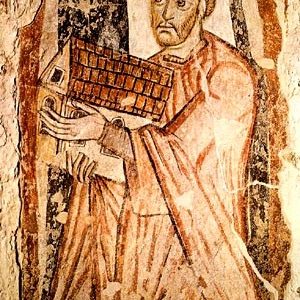Tomorrow, on February 21st, the Church celebrates the Feast of St. Peter Damian who is a Doctor of the Church. He was a monk, reformer, and fearless teacher of the Faith. He executed the reforms of popes and was an instrumental figure in the life of the Church in the 11th Century. He gave up a life of monasticism in service to Christ and His Church.
There is much that could be written about this remarkable saint
and his works, but there are three aspects of his teaching that serve as a good
reminder to help us deepen our own spiritual lives. He had a great love for the
Cross of Christ. He had a profound devotion to the Blessed Sacrament, which is
evident from his description of a Eucharistic miracle he witnessed. He also
understood the essential nature of communion in the Church.
The Cross of Christ
St. Peter Damian understood that it is through the Crucifixion
that God’s kenotic love for the Father and His people is fully realized. It is
the same self-emptying love that all followers of Christ are called to, even
though it is deeply difficult. A profound love for the Cross opens us up to the
depths of God’s love for us. In fact, it is through the Cross that we are able
to enter into union with God. It’s non-negotiable. We cannot make it to our
eternal home without the Cross of Christ and the willingness on our part to
accept the crosses given to us in this life for our own sanctification.
In his book, Doctors of the Church, Pope Emeritus Benedict
XVI explains St. Peter Damian’s great love for the Cross of Christ:
“One detail should be immediately emphasized: the Hermitage at Fonte Avellana was dedicated to the Holy Cross, and the Cross was the Christian mystery that was to fascinate Peter Damian more than all others. “Those who do not love the Cross of Christ do not love Christ,” he said (Sermo XVIII, 11, p. 117); and he describes himself as “Petrus cruces Christi servorum famulus Peter, servant of the servants of the Cross of Christ” (Ep, 9, 1.) Peter Damian addressed the most beautiful prayers to the Cross in which he reveals a vision of this mystery that has cosmic dimensions for it embraces the entire history of salvation: “O Blessed Cross,” he exclaimed, “You are venerated, preached, and honored by the faith of the Patriarchs, the predictions of the Prophets, the senate that judges the Apostles, the victorious army of Martyrs, and the throngs of all the Saints” (Sermo XLVII, 14, p. 304). Dear brothers and sisters, may the example of St. Peter Damian spur us also to always look to the Cross as the supreme act of God’s love for humankind, which has given us salvation.”
To love Christ, we are called to love the Cross. Once we come to accept and love the Cross and the crosses in our own lives, then we too can proclaim, “O Blessed Cross.” St. Peter Damian’s love for the Cross is an example to help us deepen our own devotion to the instrument of torture that brought about our redemption. This love of the Cross can also serve to strengthen us as we daily pick up our own cross and make our way towards our eternal home.
Eucharistic miracle
St. Peter Damian was blessed to witness a Eucharistic miracle and his description of the event demonstrates his deep love for the Blessed Sacrament. The vast majority of the Catholics will go through their lives seeing the Holy Eucharist purely through the eyes of faith and in the accidents of bread and wine on the altar, but there are multiple Eucharistic miracles that have taken place throughout Church history.
St. Peter Damian describes the miracle he witnessed as follows:
“This is a Eucharistic event of great importance. It took place in 1050. Giving in to a horrible temptation, a woman was about to take the Eucharistic Bread home to use the Sacred Species for sorcery. But a priest noticed what she had done and ran after her, taking away from her the Host she had sacrilegiously stolen. Then he unfolded the white linen cloth in which the sacred Host had been wrapped and found that the Host had been transformed in such a way that Half had become visibly the Body of Christ, while the other Half preserved the normal look of a Host. With such a clear testimony, God wanted to win over unbelievers and heretics who refused to accept the Real Presence of the Eucharistic mystery: in one half of the consecrated bread the Body of Christ was visible, while in the other the natural form, thus highlighting the reality of the sacramental transubstantiation taking place at the Consecration.”
Opuscul. XXXIV; Patrol. Lat., tom. CXLV. col. 573
In an age when belief in the Real Presence of Christ in the Holy Eucharist is low, this experience reveals the true nature of the Blessed Sacrament. Christ Himself tells us that it is His body, blood, soul, and divinity in the consecrated host and precious blood in the Bread of Life discourse in John 6 and when he institutes the Holy Eucharist at the Last Supper. Through Eucharistic miracles—which are gratuitous gifts from God that only serve as a confirmation of what He Himself has revealed to us in Sacred Scripture and His testimony is enough—the veil is lifted.
In a Eucharistic miracle the substantial change that takes place at the consecration is seen by the senses. This particular Eucharistic miracle shows both the accidents (bread) and the substance (Christ’s flesh) to the eyes of those who witnessed the event, which St. Peter Damian points out. This is “clear testimony” to all of us nearly 1000 years later.
Communion in the Church
By virtue of our baptism, we are not called to walk the pilgrim way on our own, rather, we are now connected to one another through Christ at the deepest levels of reality. This aspect of how we understand ecclesiology in an age of individualism is often ignored. St. Peter Damian understood the implications of the communion we share with one another in Christ. Many of the issues that he faced in the Church of his day are the same as our own day.
Benedict XVI explains St. Peter Damian’s teaching on communion within the Mystical Body:
“Communion with Christ creates among Christians a unity of love. In Letter 28, which is a brilliant ecclesiological treatise, Peter Damian develops a profound theology of the Church as communion. “Christ’s Church,” he writes, is united by the bond of charity to the point that just as she has many members so is she, mystically, entirely contained in a single member; in such a way that the whole universal Church is rightly called the one Bride of Christ in the singular, and each chosen soul, through the sacramental mystery, is considered fully Church.” This is important: not only that the whole universal Church should be united, but that the Church should be present in her totality in each one of us. Thus the service of the individual becomes “an expression of universality” (Ep 28, 9-23). However, the ideal image of “Holy Church” illustrated by Peter Damian does not correspond, as he knew well, to the reality of his time. For this reason he did not fear to denounce the state of corruption that existed in the monasteries and among the clergy, because, above all, of the practice of the conferral by the lay authorities of ecclesiastical offices; various Bishops and Abbots were behaving as the rulers of their subjects rather than as pastors of souls.”
The communion we share with Christ is meant to draw us towards
one another in love. In our Fallen state, this is difficult for all of us to
achieve, but we are still called to live in this way by doing battle with our
own sins, weaknesses, and personality flaws. We ourselves are fully in
communion with one another as one Body and also have the Church fully within
ourselves through our Glorified Head, Jesus Christ. Our service in love is both
for and within the entire Church.
The answer to divisions and corrupt forms of communion is to seek
to live that communion ourselves by growing in deeper union with Christ and
with one another. The solution begins with each person truly seeking to live in
communion. St. Peter Damian understood this when he left his beloved monastery
to become Cardinal Bishop of Ostia, a position he did not want, but that he
understood was necessary for the good of Christ’s Church. We too must accept
God’s will for the good fo the Church and how He chooses to use us within the
Body of Christ over our own desires.
St. Peter Damian’s devotion to the Cross, the Holy Eucharist, and the communion we share as the Mystical Body is an example to all of us to help us grow spiritually. The Cross is the means by which our salvation was won in a complete act of self-emptying love by God for our sake. The Blessed Sacrament is the re-presentation of the Cross were we are nourished by Christ’s Real Presence. The communion we share in love draws us into unity and service of one another and greater union with God. These are aspects of our Faith that we should re-visit time-and-time-again. May we all grow in deeper love of Christ through St. Peter Damian’s teaching.
✠
image: Detail of a miniature of Dante and Beatrice before Peter Damian, who stands within the Heaven of Saturn, with four scenes from the life of Peter Damian below, in illustration of Paradiso XXI. Image taken from f. 167 of Divina Commedia / The British Library (Public Domain).












